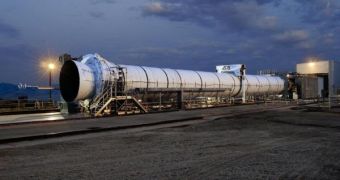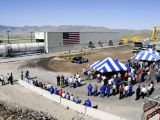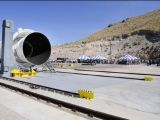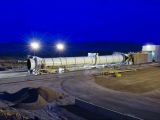In spite of the recent controversies surrounding Project Constellation – NASA's new plan of returning astronauts to the Moon by 2020 – the American space agency is pushing ahead with its scheduled tests. The newly completed rocket will undergo its first, full-scale engine test today, at a facility owned by the principal builder of the motor, ATK Space Systems, a division of the Brigham City, Utah-based Alliant Techsystems, the BBC News reports.
ARES I's massive, five-segment first stage is 154 feet (47 meters) long, and is capable of generating a maximum of 3.6 million pounds of thrust, which is about 24 percent more power than that of one twin Shuttle solid rocket booster. The first-stage development motor, or DM-1, is managed by the Ares Projects division, located at the NASA Marshall Space Flight Center, in Huntsville, Alabama. The DM-1 will be in charge of powering up the first minutes of flight after take-off, and will also be responsible for delivering the Orion Crew Exploration vehicle safely to orbit, and even further away, to the Moon.
The tests couldn't come at a more appropriate time, as NASA is preparing for its scheduled retirement of the aging space shuttle fleet – made up of Discovery, Endeavor and Atlantis – by the end of 2010. Controversies are now raging on as to whether this is the best course of action for the agency to take. A successful ARES I test would assure critics that Project Constellation is on the right track, and that the 2015 deadline for its maiden flight can be respected. However, there is still much work to be done by then, especially on Orion, and on the rocket's “elder” brother, the ARES V heavy-lift delivery system.
The test fire of the massive rocket engine will begin at 13:00 local time (1900 GMT). The gigantic piece of equipment has already been installed in a horizontal position, on a test ramp that has been heavily modified to accommodate ARES I. Previously, four-segment shuttle boosters were tested here. This is not the first installation to be modified for the Project. Work has also begun on Launch Pad 39B at the Kennedy Space Center (KSC), in Cape Canaveral, Florida. The pad needs to be able to host a much thinner and taller rocket than the shuttles used for their flights.

 14 DAY TRIAL //
14 DAY TRIAL // 


